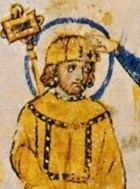Dynasty Nikephorian Parents Theophylact Rhangabe | Name Michael Rangabe Role Roman emperor | |
 | ||
Reign 2 October 811 – 22 June 813 Coronation 2 October 811Hagia Sophia Burial Church on Prote Island, transferred to Monastery of Satyros Issue TheophylaktosStaurakiosNiketasGeorgoTheophano Children Ignatios of Constantinople, Theophylact, Georgo, Theophano Similar People Leo V the Armenian, Michael IV the Paphlagonian, Michael III, Michael VIII Palaiologos, Michael Shishman of Bulgaria | ||
Michael I Rangabe, 811-813
Michael I Rangabe | Wikipedia audio article
Michael I Rhangabe (Greek: Μιχαῆλ A' Ῥαγγαβέ, Mikhaēl I Rhangabe; c. 770 – 11 January 844) was Eastern Roman Emperor from 811 to 813.
Contents
Michael was the son of the patrician Theophylact Rhangabe, the admiral of the Aegean fleet. He married Prokopia, the daughter of the future Emperor Nikephoros I, and received the high court dignity of kouropalatēs after his father-in-law's accession in 802.
Background
Michael survived Nikephoros' disastrous campaign against Krum of Bulgaria, and was considered a more appropriate candidate for the throne than his severely injured brother-in-law Staurakios. When Michael's wife Prokopia failed to persuade her brother to name Michael as his successor, a group of senior officials (the magistros Theoktistos, the Domestic of the Schools Stephen, and Patriarch Nikephoros) forced Staurakios to abdicate in his favor on 2 October 811.
Michael I attempted to carry out a policy of reconciliation, abandoning the exacting taxation instituted by Nikephoros I. While reducing imperial income, Michael generously distributed money to the army, the bureaucracy, and the Church. Elected with the support of the Orthodox party in the Church, Michael diligently persecuted the iconoclasts and forced the Patriarch Nikephoros to back down in his dispute with Theodore of Stoudios, the influential abbot of the monastery of Stoudios. Michael's piety won him a very positive estimation in the work of the chronicler Theophanes the Confessor.
In 812 Michael I reopened negotiations with the Franks, and recognized Charlemagne as basileus (emperor) (but not as Emperor of the Romans). In exchange for that recognition, Venice was returned to the Empire. However, under the influence of Theodore, Michael rejected the peace terms offered by Krum and provoked the capture of Mesembria (Nesebar) by the Bulgarians. After an initial success in spring 813, Michael's army prepared for a major engagement at Versinikia near Adrianople in June. The imperial army was turned to flight and the Emperor's position was seriously weakened. With conspiracy in the air, Michael preempted events by abdicating in favor of the general Leo the Armenian and becoming a monk (under the name Athanasios). His sons were castrated and relegated into monasteries, one of them, Niketas (renamed Ignatios), eventually becoming Patriarch of Constantinople. Michael died peacefully on 11 January 844.
Family
By his wife Prokopia, Michael I had at least five children:
